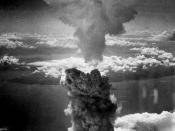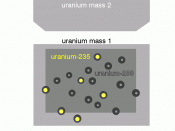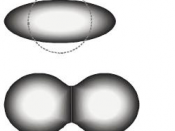Energy is a form of power. In this essay I will talk about the things that energy has to do with and alot more that you will learn from. I think that you will learn something from this.
Nuclear Energy, energy released during the splitting or fusing of atomic nuclei. The energy of any system, whether physical, chemical, or nuclear, is manifested by the system's ability to do work or to release heat or radiation. The total energy in a system is always conserved, but it can be transferred to another system or changed in form.
The two key characteristics of nuclear fission important for the practical release of nuclear energy are both evident in equation (2). First, the energy per fission is very large. In practical units, the fission of 1 kg (2.2 lb) of uranium-235 releases 18.7 million kilowatt-hours as heat. Second, the fission process initiated by the absorption of one neutron in uranium-235 releases about 2.5
neutrons, on the average, from the split nuclei. The neutrons released in this manner quickly cause the fission of two more atoms, thereby releasing four or more additional neutrons and initiating a self-sustaining series of nuclear fissions, or a chain reaction, which results in continuous release of nuclear energy.
Naturally occurring uranium contains only 0.71 percent uranium-235; the remainder is the nonfissile isotope uranium-238. A mass of natural uranium by itself, no matter how large, cannot sustain a chain reaction because only the uranium-235 is easily fissionable. The probability that a fission neutron with an initial energy of about 1 MeV will induce fission is rather low, but the probability can be increased by a factor of hundreds when the neutron is slowed down through a series of elastic collisions with light nuclei such as hydrogen, deuterium, or carbon. This...


